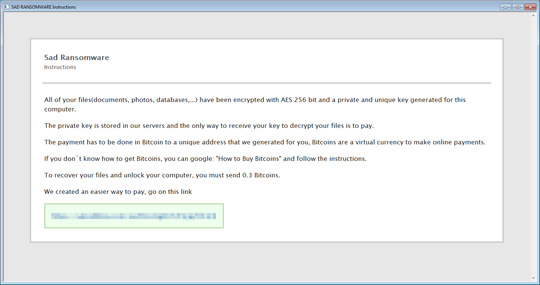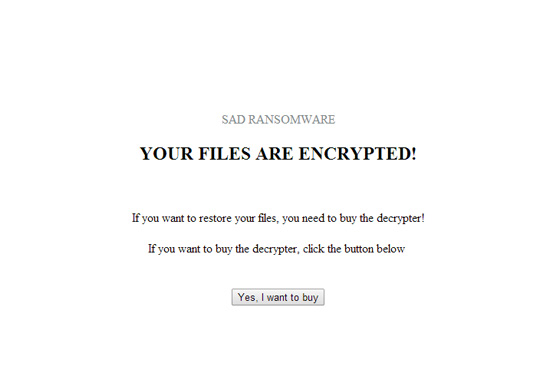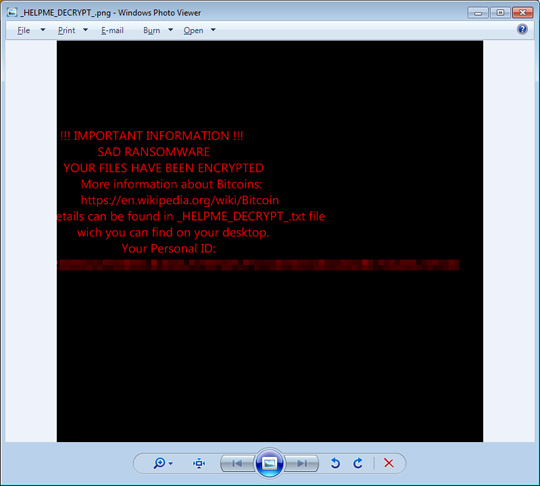RANSOM_SAD.A
Ransom.CryptXXX (Symantec); Ransom.Sad (Malwarebytes)
Windows


Threat Type: Ransomware
Destructiveness: No
Encrypted: No
In the wild: Yes
OVERVIEW
Dropped by other malware, Downloaded from the Internet
This Ransomware arrives on a system as a file dropped by other malware or as a file downloaded unknowingly by users when visiting malicious sites.
It connects to certain websites to send and receive information. It gathers information and reports it to its servers. It is capable of encrypting files in the affected system.
It encrypts files found in specific folders. It drops files as ransom note.
TECHNICAL DETAILS
81,920 bytes
EXE
No
03 Nov 2017
Connects to URLs/IPs, Steals information, Displays message/message boxes, Encrypts files
Arrival Details
This Ransomware arrives on a system as a file dropped by other malware or as a file downloaded unknowingly by users when visiting malicious sites.
Installation
This Ransomware drops the following copies of itself into the affected system:
- {Drive Letter}:\Picture.exe
- %User Temp%\{Malware Filename}{Random Letter/s}.exe
(Note: %User Temp% is the user's temporary folder, where it usually is C:\Documents and Settings\{user name}\Local Settings\Temp on Windows 2000, Windows Server 2003, and Windows XP (32- and 64-bit); C:\Users\{user name}\AppData\Local\Temp on Windows Vista (32- and 64-bit), Windows 7 (32- and 64-bit), Windows 8 (32- and 64-bit), Windows 8.1 (32- and 64-bit), Windows Server 2008, and Windows Server 2012.)
It drops the following file(s)/component(s):
- %User Temp%\id.txt - contains the Generated GUID for the appended extension of the ransomware
(Note: %User Temp% is the user's temporary folder, where it usually is C:\Documents and Settings\{user name}\Local Settings\Temp on Windows 2000, Windows Server 2003, and Windows XP (32- and 64-bit); C:\Users\{user name}\AppData\Local\Temp on Windows Vista (32- and 64-bit), Windows 7 (32- and 64-bit), Windows 8 (32- and 64-bit), Windows 8.1 (32- and 64-bit), Windows Server 2008, and Windows Server 2012.)
Other System Modifications
This Ransomware changes the desktop wallpaper by modifying the following registry entries:
HKEY_CURRENT_USER\Control Panel\Desktop
Wallpaper = %Desktop%\_HELPME_DECRYPT_.png
Other Details
This Ransomware connects to the following website to send and receive information:
- http://database1234.{BLOCKED}d.net/cry.php?hwid={Generated GUID}%20&osname={OS Name}l%20&pcname={Machine Name}&key={Generated Key}
It gathers the following information and reports it to its servers:
- Generated GUID
- OS Name
- Machine Name
- Generated Key
It is capable of encrypting files in the affected system.
Ransomware Routine
This Ransomware encrypts files found in the following folders:
- {All Available Drives}:\
- %User Profile%\Documents
- %User Profile%\Downloads
- %User Profile%\Pictures
- %User Profile%\Music
- %User Profile%\Videos
(Note: %User Profile% is the current user's profile folder, which is usually C:\Documents and Settings\{user name} on Windows 2000, XP, and Server 2003, or C:\Users\{user name} on Windows Vista and 7.)
It avoids encrypting files found in the following folders:
- {Filename}.exe
- {Filename}.dll
- %System Root%
- %Desktop%
(Note: %System Root% is the Windows root folder, where it usually is C:\ on all Windows operating system versions.. %Desktop% is the desktop folder, where it usually is C:\Documents and Settings\{user name}\Desktop in Windows 2000, Windows Server 2003, and Windows XP (32- and 64-bit); C:\Users\{user name}\Desktop in Windows Vista (32- and 64-bit), Windows 7 (32- and 64-bit), Windows 8 (32- and 64-bit), Windows 8.1 (32- and 64-bit), Windows Server 2008, and Windows Server 2012.)
It appends the following extension to the file name of the encrypted files:
- .{Generated GUID}
It drops the following file(s) as ransom note:
- %Desktop%\_HELPME_DECRYPT_.html
- %Desktop%\_HELPME_DECRYPT_.txt
- %Desktop%_HELPME_DECRYPT_.hta
(Note: %Desktop% is the desktop folder, where it usually is C:\Documents and Settings\{user name}\Desktop in Windows 2000, Windows Server 2003, and Windows XP (32- and 64-bit); C:\Users\{user name}\Desktop in Windows Vista (32- and 64-bit), Windows 7 (32- and 64-bit), Windows 8 (32- and 64-bit), Windows 8.1 (32- and 64-bit), Windows Server 2008, and Windows Server 2012.)
NOTES:
This ransomware displays the following:




SOLUTION
9.850
13.758.08
03 Nov 2017
13.759.00
04 Nov 2017
Step 1
Before doing any scans, Windows XP, Windows Vista, and Windows 7 users must disable System Restore to allow full scanning of their computers.
Step 2
Note that not all files, folders, and registry keys and entries are installed on your computer during this malware's/spyware's/grayware's execution. This may be due to incomplete installation or other operating system conditions. If you do not find the same files/folders/registry information, please proceed to the next step.
Step 3
Restart in Safe Mode
Step 4
Reset your Desktop properties
Step 5
Search and delete these files
- {Drive Letter}:\Picture.exe
- %User Temp%\{Malware Filename}{Random Letter/s}.exe
- %User Temp%\id.txt
- %Desktop%\_HELPME_DECRYPT_.png
- %Desktop%\_HELPME_DECRYPT_.html
- %Desktop%\_HELPME_DECRYPT_.txt
- %Desktop%\_HELPME_DECRYPT_.hta
Step 6
Restart in normal mode and scan your computer with your Trend Micro product for files detected as RANSOM_SAD.A. If the detected files have already been cleaned, deleted, or quarantined by your Trend Micro product, no further step is required. You may opt to simply delete the quarantined files. Please check this Knowledge Base page for more information.
Step 7
Restore encrypted files from backup.
Did this description help? Tell us how we did.


